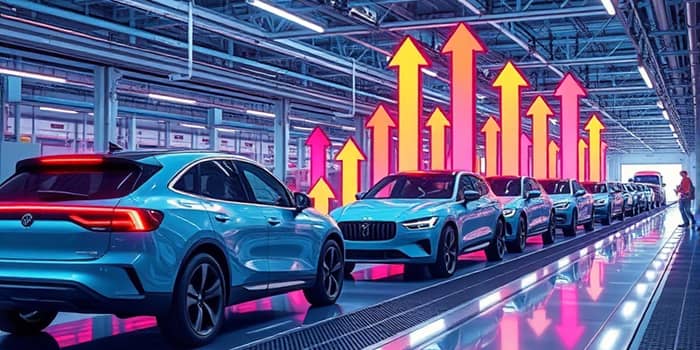
The automotive sector is witnessing a remarkable turnaround as electric vehicle output accelerates worldwide. Investors are taking note of the surging global EV sales trends that are redefining market dynamics.
This article dives into the data behind the rally, profiles leading companies, examines macroeconomic drivers, and explores the technological innovations powering the resurgence.
Electric vehicle adoption hit new heights in 2025, with global sales projected to exceed 20 million units—accounting for more than 25% of all new vehicle deliveries. This marks a 35% increase over Q1 2024, when just over 4 million EVs were sold.
Regional performance has been equally impressive. In the U.S., Q1 2025 saw nearly 300,000 new EV sales, representing 7.5% of new vehicle transactions—a jump from 7% a year prior. Meanwhile, China maintains its leadership position, with EVs comprising almost half of all new car sales in 2024.
Europe’s market remains robust as well, driven by policy incentives and expanding charging infrastructure. Collectively, these trends illustrate the massive growth potential worldwide for electric mobility.
After underperforming during periods of high interest rates, EV-related stocks are staging a comeback. The Federal Reserve’s pause on rate hikes has lowered borrowing costs, fueling renewed consumer demand and investor optimism.
Key companies at the forefront of this rebound include:
This group exemplifies the renewed investor confidence in EV stocks, offering diversified exposure to different segments of the value chain.
Several overarching factors are catalyzing the automotive stock recovery. With interest rates stabilizing, financing costs for both consumers and automakers have become more favorable.
The Inflation Reduction Act (IRA) remains a cornerstone policy, extending federal tax credits for clean energy vehicles. Eligibility requirements tied to North American battery sourcing are spurring domestic investment and boosting confidence in U.S.-based manufacturers.
Manufacturing scale-up is critical to meeting demand. By the end of 2025, global lithium-ion capacity is expected to reach 3.8 terawatt-hours, roughly double current forecasts. This rapid expansion underlines unprecedented manufacturing capacity growth.
Beyond volume, technology is evolving. Automakers and suppliers are investing heavily in silicon carbide chips to improve efficiency and performance. Meanwhile, research into transformative solid-state battery technology promises faster charging times and longer driving ranges.
Additionally, the rise of grid-scale storage solutions leverages the same battery platforms, broadening revenue streams for component manufacturers and further legitimizing long-term growth narratives.
Despite the surge, EVs still represent a small fraction of the total vehicle fleet. In key markets, penetration ranges from just 1% to 7.5%, indicating expanding battery production capabilities will be essential to sustaining momentum.
Analysts forecast continued adoption through 2032, driven by falling battery costs, stricter emissions regulations, and consumer preferences shifting toward sustainable mobility. Automotive employment is expected to pivot toward battery assembly and EV components, reshaping regional economies.
For quick reference, this table summarizes the critical metrics shaping the market rebound:
The convergence of robust EV demand, supportive macroeconomic policy, and technological breakthroughs has ignited a powerful rebound in automotive stocks. Investors who recognize the end of interest rate hikes and the momentum behind cleaner transportation stand to benefit substantially.
As battery capacities expand and charging networks proliferate, the path ahead for electric mobility—and the stocks tied to it—appears brighter than ever. For those seeking exposure, a balanced portfolio including industry leaders, component suppliers, and emerging innovators offers a comprehensive way to participate in this transformative journey.
References













